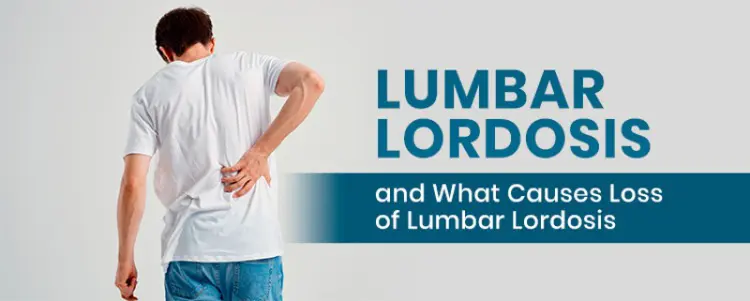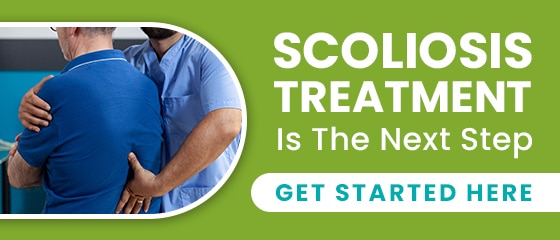Part of understanding the structure and function of the spine means understanding why it’s curved in the first place. The spine is complex with many different parts that all play a role in its biomechanics. ‘Lordosis’ refers to the natural C-shaped curvature of the spine, and when there is a loss of lumbar lordosis, a syndrome known as ‘flatback’ can develop.
‘Lumbar’ refers to the lower-back section of the spine, and ‘lordosis’ refers to the spine’s C-shaped sideways curvatures. When there is a loss of lumbar lordosis, the lower spine’s natural inward curvature has become straighter, making that section of the spine flatter than it should be. Conversely, an exaggerated inward curve of the spine can lead to posture issues and discomfort. Keep reading to find out what causes a loss of lumbar lordosis.
In order to better understand what’s involved in a loss of lumbar lordosis, as well as the condition that can develop as a result, let’s first explore some basic spinal anatomy and terminology; then we can have a more detailed look at lumbar lordosis and flatback syndrome
The Spine’s Natural Curvatures: The Lordotic Curve
With all the focus on the many spinal conditions that can develop and how they affect the parts and structure of the spine, it’s important to remember just how important the spine’s natural curvatures are.
When you look at the spine from different angles, you can see the curvatures that characterize different sections of the spine.
If you were to look at an individual straight on, in the frontal plane, a healthy spine would look straight. If you were to look at that same person from the side view (also known as the sagittal plane), you would see a series of curves to the spine giving it a soft ‘S’ shape.
The spine has three main sections: cervical (neck), thoracic (middle and upper back), and lumbar (lower back). Each section has a corresponding natural curvature type; the cervical and lumbar spinal sections have an inward C-shaped curvature known as ‘lordosis’, specifically referred to as the ‘lordotic curve’, and the thoracic spine has an outward reverse C-shaped curvature known as ‘kyphosis’.
This complex structure of the spine is there for a reason; it gives the spine its strength, flexibility, and facilitates the even distribution of mechanical stress that’s incurred during daily movement.
For an individual to have an economical gait and posture (meaning not requiring excess energy to maintain), the curves in the sagittal plane have to be balanced. An individual’s gravity line should naturally fall through the head, cervical spine, behind the sacrum (pelvis area), and through the center of the hips. If this line of gravity is maintained, a person can easily maintain a straight and upright posture, and a healthy gait, while investing minimal energy.
But that line of gravity can only be maintained if the spine’s natural curvatures are in place and balanced. Once that balance is thrown off, so too is the body’s center of gravity.
A loss of lordosis in the lumbar spine is exactly that: a loss of one of the spine’s natural curvatures, and this affects the other curvatures as it throws off the spine’s overall biomechanics.
A loss of lordosis means there is less of a curvature than there should be, and that section of the spine becomes straighter than it should be as a result; this can lead to the development of a condition known as ‘flatback syndrome’.
Every patient and condition will have their own unique set of characteristics, and while symptoms can vary greatly based on a number of factors such as age, physical fitness, and condition severity, there are some common symptoms of flatback syndrome a person can watch for.
Common Symptoms of Flatback Syndrome
As mentioned, when the spine loses one or more of its healthy and natural curvatures, uneven forces are introduced to the body.
The main symptoms of flatback syndrome, which are also symptoms of lordosis, are issues of balance and symmetry. For some people with a loss of lumbar lordosis, this can make it difficult to stand upright, especially for long periods of time.
As it takes more energy and active effort to maintain erect posture and gait, something as simple as standing can be a challenge. Often, in addition to low back pain, neck, thigh and groin pain can be an issue for people with flatback syndrome.
Typically, these symptoms can increase throughout the day as the body gets more fatigued from its efforts to adjust to its uneconomical stance and gait. Often, individuals with flatback syndrome will frequently flex and/or bend their knees and hips to help them maintain an upright position, and as the day progresses, this gets increasingly tiring.
In addition, individuals can experience neck and upper back pain resulting from the strain of trying to align themselves. Depending on the severity of the condition, these symptoms can range from mild to severe; once they reach severe levels, the loss of lumbar lordosis and resulting flatback syndrome can interfere with an individual’s ability to perform daily activities.
This leads us into the next logical question of, what causes loss of lumbar lordosis to occur?
Loss of Lumbar Lordosis Causes in the Lumbar Spine
As a loss of lumbar lordosis increases and starts to produce symptoms, the development of flatback syndrome is a common result. Certain groups of people are more prone to develop lordosis due to various factors, which can also contribute to the loss of lumbar lordosis.
Flatback syndrome was first found in patients who had undergone spinal-fusion surgery to correct their scoliosis. Now, this was in the surgery’s earlier days, between the 1960s and 80s, and while there have been significant changes since then, making these problems less common, the surgery is still an invasive procedure with a risk of serious side effects and complications.
Early spinal fusions were performed using Harrington rod instrumentation, and this has since been found to flatten the natural sway of the lumbar spine, particularly in cases where the fusion extended down into the L4 or L5 vertebrae (spinal bones) of the lower lumbar spine.
What was observed in patients who underwent spinal fusion during its early days with Harrington rod instrumentation was that as the natural degenerative effects of aging happened over time, such as intervertebral spinal disc degeneration, issues started to occur below the site of fusion; those peoples’ ability to stand upright became more difficult, leading to pain and discomfort.
At the core of spine health lies the concept of lordosis. To define it simply, the lordosis definition pertains to the natural inward curve of the spine, particularly noticeable in the lumbar (lower back) and cervical (neck) regions. These lordotic curves play a crucial role in balancing our spinal structure and facilitating movement. However, when there’s a straightening of the normal lumbar lordosis, the lumbar spine loses its typical curvature, often leading to chronic pain and discomfort.
This straightening of normal lumbar lordosis is an abnormal spinal curvature that can have significant implications on an individual’s overall spine health. While the lumbar lordosis definition specifically refers to the lower back curve, it’s worth noting that similar issues can arise with cervical lordosis in the neck region. To manage and potentially correct these irregularities in spinal curves, physical therapy can be an invaluable tool. By understanding and addressing these changes early on, individuals can potentially mitigate the risks associated with abnormal spinal curvatures and maintain optimal spine health.
Understanding the factors that contribute to the loss of lumbar lordosis, such as rotoscoliosis or various degrees of scoliosis, including mild scoliosis and more severe cases, is essential for comprehending how scoliosis is classified and for devising appropriate treatment strategies for maintaining a healthy spinal curvature.
Now, in addition to being a potential result of undergoing spinal-fusion surgery, flatback syndrome can also be caused by other factors.
Additional Causes of Flatback Syndrome: Poor Posture
While loss of lumbar lordosis can be the result of undergoing spinal-fusion surgery, it can also be caused by underlying spinal conditions such as degenerative disc disease and ankylosing spondylitis.
In addition, trauma can lead to injury that results in the development of flatback syndrome, and as mentioned earlier, the condition can also develop as a complication of undergoing spinal surgery. Magnetic resonance imaging is often used to diagnose these spinal conditions, providing detailed images that help in understanding the extent of the damage.
Degenerative Disc Disease
As a person ages, the intervertebral discs of the spine can start to deteriorate. The spine’s intervertebral discs sit between the vertebrae of the spine, helping preserve the spine’s natural curvatures, acting as ligaments holding the spine together, and providing cushioning between adjacent vertebrae so they don’t rub against each other. Basically, the spine’s discs act as the body’s shock absorbers.
When the discs start to erode, the spine can experience a number of symptoms such as pain and stiffness, reduced mobility, and an inability to maintain the spine’s natural and healthy curvatures.
The intervertebral disc degeneration that characterizes degenerative disc disease can cause the spine to flatten out and lose its natural lordosis.
Ankylosing Spondylitis
Ankylosing spondylitis is arthritic inflammation of the spine. It’s known to cause stiffness and spinal rigidity. There are different severity levels, and in severe cases, it can lead to the formation of new bone and fusion, referred to as ‘ankylosis’; this can result in sections of the spine becoming fused in a flat fixed position.
When this happens, the spine’s natural lordosis is lost as the affected section becomes flatter.
Vertebral Compression Fractures
As mentioned earlier, vertebrae are the bones of the spine. When one or more of these bones become compressed and collapse, this is known as a ‘vertebral compression fracture’.
Now, this can occur as a result of trauma and injury, but it is most commonly found in older adults with osteoporosis: a condition that substantially weakens the bones.
Post-Laminectomy Syndrome
We already discussed how flatback syndrome can be a complication of undergoing spinal fusion, but it can also be caused by another surgical procedure: laminectomy.
Laminectomies, also called ‘decompression surgery’, are performed on patients who need more space in their spinal canal, most often to relieve pressure on the spinal cord and/or nerves. This is done by removing lamina (back portion of a vertebra covering the spinal canal).
Sometimes, the procedure can lead to a loss of lordosis and the development of flatback syndrome.
Getting Flatback Syndrome Diagnosed with Diagnostic Imaging Procedure
People experiencing difficulty standing upright and/or lower back, leg, and hip pain, are frequent indicators of an upcoming flatback-syndrome diagnosis.
A diagnosis is generally reached through a combination of taking a patient’s history, a physical examination, and X-rays of the spine. This process is similar to how lordosis is diagnosed, which involves a comprehensive medical history, physical examination, and various diagnostic tests.
Your child’s doctor plays a crucial role in diagnosing lordosis through a comprehensive medical evaluation, which includes gathering a complete medical history and performing physical exams, along with possibly conducting diagnostic tests to confirm the condition.
As mentioned earlier, prior spinal surgery is often a cause of flatback syndrome, so an important part of taking a patient’s history isn’t just relevant genetic conditions and diseases, but also their surgical history.
In addition to an X-ray of the spine, a doctor might also order an MRI or a CT scan to identify any potential problems with the soft tissues of the spinal cord, nerves, and/or the intervertebral discs; this helps determine the most effective and safest treatment plan moving forward.
Treatment for Loss of Lumbar Lordosis and Flatback Syndrome
While some patients may opt for surgery as a first-line treatment, here at the Center, we specialize in non-invasive methods to treat a variety of complex spinal conditions, including loss of lumbar lordosis and flatback syndrome. Understanding how lordosis is treated is crucial, as it often requires careful monitoring by a spine specialist and may vary based on underlying conditions.
At our Center, the nonsurgical treatment approach begins with a thorough assessment, including a physical examination, complete medical history, and if necessary, X-rays of the full spine in various positions. For younger patients, age is a critical factor in determining the most appropriate treatment, as it can influence the type of interventions needed.
Customized Treatment Plans
Each patient’s treatment plan is fully customized to address their specific needs. We integrate various treatment disciplines to ensure that our patients benefit from a holistic approach. This includes chiropractic adjustments, targeted exercises, and in-office rehabilitation designed to strengthen the core muscles that support and stabilize the spine.
Chiropractic Adjustments and Exercise Therapy
Chiropractic care is central to our treatment approach, helping to restore as much of the spine’s natural curvature as possible. In conjunction with chiropractic adjustments, we emphasize exercise therapy. Specific exercises are designed to stretch and loosen the lower back’s extensor muscles, which often become stiff and tight due to loss of lumbar lordosis.
The Role of Flexibility in Treatment
Maintaining flexibility in the spine is critical. Spines that are loose and flexible respond better to treatment and are less likely to cause ongoing back problems. Although exercises alone may not induce structural changes, they are essential for maintaining spinal flexibility and enhancing the effects of other treatment modalities.
Fixing Lumbar Lordosis: Key Considerations
Lumbar lordosis is the natural inward curve of the lower back that helps support the body’s weight and maintain proper spinal alignment. Loss of lumbar lordosis can lead to conditions such as hyperlordosis (an excessive curve) or hypolordosis (a reduced or flattened curve).
Differentiating Lordosis and Kyphosis
It’s essential to differentiate between lordosis and kyphosis when addressing spinal issues. While lordosis refers to the inward curve of the lower back, kyphosis involves an outward curve in the upper back. Misidentifying these conditions can lead to inappropriate treatment.
Causes and Risk Factors
Factors contributing to the loss of lumbar lordosis include poor posture, muscle imbalances, and underlying spinal issues such as scoliosis or degenerative disc disease. These factors must be identified and addressed to effectively fix lumbar lordosis.
Treatment Options to Fix Lumbar Lordosis
Fixing lumbar lordosis requires a combination of targeted exercises, chiropractic adjustments, and other therapies. Physical therapy focuses on strengthening the core and lower back muscles, which play a crucial role in supporting the spine and maintaining proper alignment.
Our integrative approach combines chiropractic care with exercise and rehabilitation to address the underlying causes of lumbar lordosis. By restoring the spine’s natural curvature, we improve spinal alignment and overall well-being, reducing the risk of further complications.

Conclusion
As such an important part of human anatomy, maintaining the spine’s health is crucial to a person’s overall health and wellness.
Not only does the spine allow us to maintain a straight and upright posture, it also facilitates our flexible movement, and together with the brain, it forms the body’s central nervous system.
For the spine to fulfill its many roles, its individual parts and characteristic curvatures have to be preserved for optimal function. The spine has three main sections with each having a related curvature.
The two types of spinal curvatures are known as ‘lordosis’ and ‘kyphosis’. Lordosis refers to the natural C-shaped curvatures of the cervical and lumbar spine, while kyphosis refers to the reverse C-shaped curvature of the thoracic spine.
If there is a loss of one or more of these curvatures, the overall biomechanics of the spine are disrupted as the body tries to adjust to the shift in alignment.
When the lumbar spine develops an under-pronounced lordosis, this means the affected section of the spine has lost its natural curvature, becoming flatter and straighter. When this loss of lumbar lordosis continues and starts to produce symptoms such as an inability to stand upright and related back and/or neck, hip, and leg pain, flatback syndrome can develop.
As is the case with most complex spinal conditions, a loss of lumbar lordosis can have multiple potential causes, one potential cause being the result of spinal-fusion surgery. This is especially the case when the fusion takes place in the lower lumbar spine as the fused section becomes fixed and immovable, although modern advancements in instrumentation used has greatly lessened this occurrence.
Other common causes of a loss of lumbar lordosis include degenerative disc disease, ankylosing spondylitis, vertebral compression fractures, or complications of another surgical procedure: laminectomy.
Here at the Scoliosis Reduction Center®, we do our best to reach treatment success through a more natural and functional approach, in order to avoid the hardships and potential complications associated with invasive surgical procedures such as spinal fusion.
If you or a loved one is noticing an increasing difficulty in standing upright, and/or the presence of back, neck, hip, or leg pain, these are common indicators of a loss of lumbar lordosis. If part of your medical history includes previous spinal-fusion surgery, there is a high likelihood that flatback syndrome could be the cause of your symptoms.





